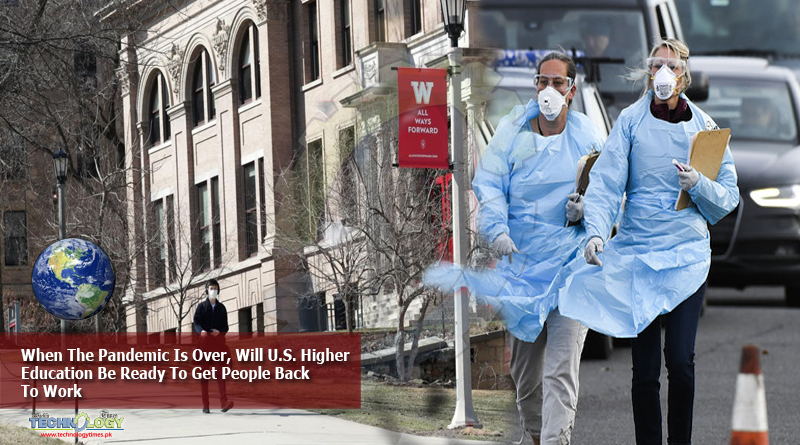When the pandemic is finally defeated with some combination of universal testing, herd immunity, antivirals, and ideally a vaccine, America will need to get back to work. While the current recession was not caused by the kind of structural failure of the 2008-09 recession, the impact on workers is much worse. In 2008-09, 8.8 million jobs were lost during those two years according to the Bureau of Labor Statistics.

In just the last few weeks more than 10.5 million claims for unemployment have been filed and it will get worse as large swaths of the economy remain shut down.
When the time comes, is American higher education ready to do its part in quickly getting people back into the workforce?
The traditional strengths of American higher education – the measured and careful design of curriculum, two and four-year degrees that represent substantial learning over time, a rich coming-of-age experience for those who can afford it, stunning campuses – may not be enough to meet the challenges that lie ahead. For this economic crisis, America needs a higher education industry that is quickly responsive to workforce needs, that can get people retooled in two and four months, not years, that is affordable, and that better accommodates the working adults and under-served populations too often neglected by four-year colleges and universities.
A growing body of practice and innovative and new models of education point the way forward. Overall, reform of higher education requires us to focus on outcomes and rigorous assessment of skills and knowledge. Higher education is consumed with inputs and delivery. We measure how long people sat, using the credit hour as the basis for everything from program design to how we disperse more than $160 billion of federal financial aid every year, instead of measuring what students actually learned. Taxpayers pay for class time instead of actual learning. Innovative institutions and programs such as Dallas Community College, the BYU Pathways Program, Texas A&M Commerce, Western Governors University, and others provide new models, many of them based on competency-based education.Today In: Education
A shift to competency-based learning, where the claims for what students know and can do are tested through performance-based assessments, free us to worry less about delivery and worry more about the actual performance of our graduates and institutions. If employers can be reassured of what graduates know and can do, they will be less concerned with the brand name of the institution, the design of the curriculum, or how long someone sat in class. The benefits abound, including the unleashing of innovation in delivery and greater flexibility for students. For example, if major employers come together around agreed upon frameworks for skills and credentials, the inefficiency and real damage to students created by the current transfer credit system (where credits are lost, Pandemic costs go up, and racial inequities are exacerbated) could be addressed. Students could own their transcripts, not the institutions they attended – what some have called “student sovereignty.”
Given the scope of the employment challenge, people without degrees will need some form of post-secondary credential and those with degrees will need the additional credentials that can more quickly unlock opportunity. Many need something faster than a two- or four-year degree program, yet higher education is largely focused on those long degree formats and the federal financial aid program is not designed for the kind of shorter term, job-focused, high-quality programs learners need. Colleges and universities need to launch such programs in high-demand areas and the federal government has to help those who most need such programs with aid.
PROMOTEDDeloitte BRANDVOICE | Paid ProgramElevating The Next Generation Of World LeadersGrads of Life BRANDVOICE | Paid ProgramOpportunity Employment: 4 Trends Pandemic Being Escalated By COVID-19Civic Nation BRANDVOICE | Paid ProgramWomen’s New Pandemic-Related Realities Magnify The Inequities In Our Systems And Families
Employers also have an important part to play in the readiness and reform of higher education. When unemployment recently hit historic lows, employers were willing to look beyond the degree as a signal of workplace readiness. There was much discussion of micro-credentials – sub-degree, shorter term learning typically focused on key skills – and whether a college degree was still required to land a good job. The war for talent forced employers to drop the college degree as a hiring filter in many cases.
By contrast, during the high unemployment years, during and immediately after the last recession, employers had their pick of talent and used the degree as a screen for jobs that did not typically require post-secondary education. A 2015 report from the Federal Reserve Bank of New York found that approximately 50% of the graduates of 2009 were under-employed. The graduates of 2020 and probably 2021 face Pandemic a grim employment market and a key question is whether or not employers will revert back to the college degree as a requirement for non-degree work, repeating the patterns of 2008-2012. If they do, the reforms for which higher education is ripe will be set back another ten years.
In a recent Financial Times essay, Indian novelist Arundhati Roy writes, “Historically, pandemic have forced humans to break with the past and imagine their world anew. This one is no different. It is a portal, a gateway between one world and the next.” Change in higher education comes painfully slowly. The current crisis allows us, impels us, to imagine our world anew for the good of the country.
Originally Publish at: https://www.forbes.com/
